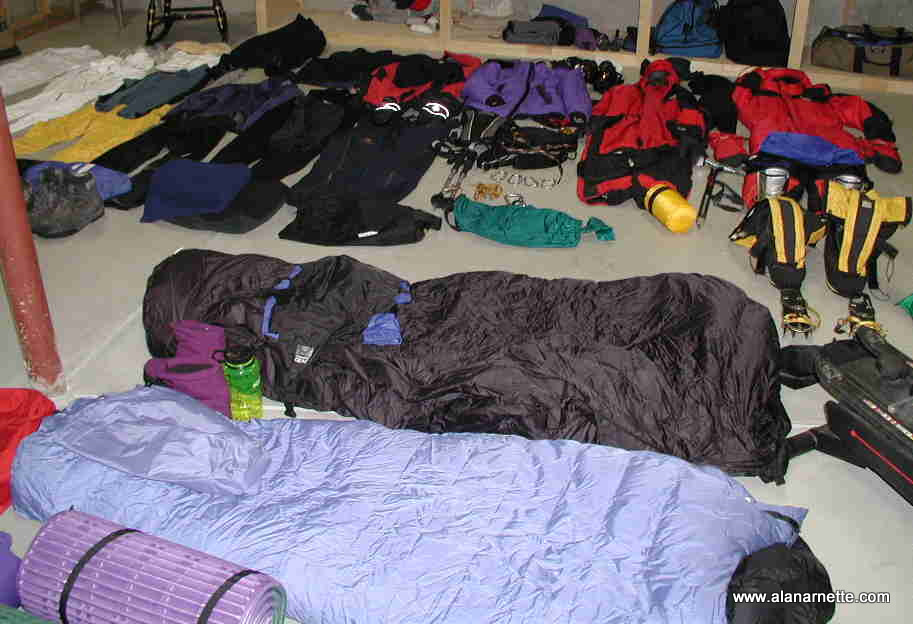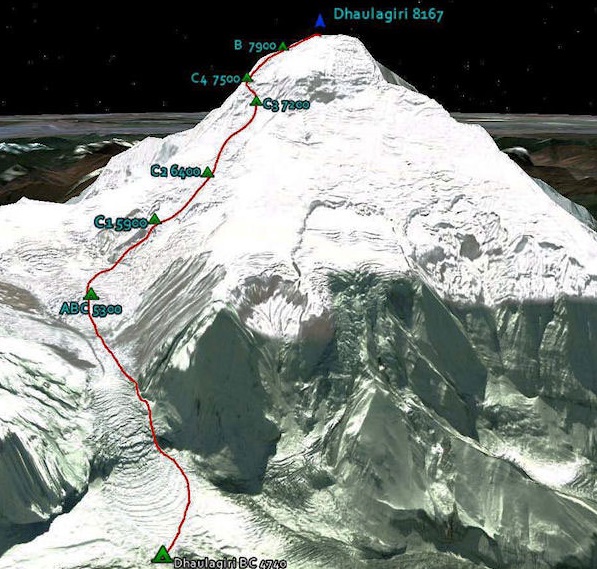Dhaulagiri is considered
one of the 'attainable" 8000 meter mountains. I am focusing on the
Northeast Ridge since it is the normal route and the one I will use for
my 2017 attempt. I am asked many questions about climbing especially since
I am not a professional climber. So here are the most popular questions
with my answers. As always, this information is based on my experience
and are my opinions so always consult with a professional before making
any serious climbing decisions.
Q: Where is Dhaulagiri?
A: It is located in west-central Nepal about 50 miles
from Kathmandu. It is the 7th highest mountain on earth at 26,795' and
has a reputation as one of the "achievable" 8000m mountains.
The nearest airport is Kathmandu. Most people fly into Kathmandu and
take about a week by off-road vehicles and trekking to reach base camp.
Some teams will helicopter in and out of base camp saving time but then
spend time acclimatizing before going higher.
Q: When is it usually will climb?
A: As with most Himalayan peaks, pre and post monsoon but
Spring is popular since every day it gets warmer with less threat of
snow. The Fall season is just the opposite with colder days and increasingly
unstable weather. I will climb in April. Of the 480 total summits, 310
have occured in Spring and 156 in Autumn.
Q: I understand that Dhaulagiri is an easy 8000m climb.
A: It is not 'easy' - no 8000 meter mountain is easy.
It is a serious high-altitude mountain where climbers lose their lives
every year. I will update this answer after the climb.
Q: How does Dhaulagiri compare with Denali or Aconcagua?
A: The climbing is significantly more difficult than either
of these mountains. It is a longer climb but similar to Denali in spirit
in that you climb on steep snow slopes most of the time but obviously
at a significantly higher altitude. Also you are using fixed ropes continuously
from Camp 1 on. Finally on Denali you are pulling a sled with personal
and group gear whereas on Dhaulagiri Sherpas usually carry the tents
and stoves while you carry your personal gear including food, clothing
and sleeping bag and pads. This depends on your expedition logistics.
It is measurably more difficult than Aconcagua due to the snow, weather
and length of the expedition. Huascaran is a better comparison than Aconcagua.
I will update this answer after the climb.
Q: How does Dhaulagiri compare with Everest or other 8,000m
peaks?
A: It is a great training climb for aspiring Everest climbers
to see how their body reacts to high altitude - 8,000m. I will update
this answer after the climb.
Q: Is a Dhaulagiri climb dangerous?
A: Absolutely. You should only attempt Dhaulagiri if you
have the proper experience and logistics for emergency situations. Most
deaths are a result of avalanches and falls but the weather and altitude
takes it's toll.
Q: How many people had summited and how many people had died
trying?
A: According to the Himalayan Database 64 people have
died with about 480 summits through the Autumn of 2016. The success rate
is about 60%. About two thirds summit without using supplemental
oxygen. The first ascent was on May 13,1960 by a Swiss/Austrian/Nepali
expedition of Kurt Diemberger, P. Diener, E. Forrer, A. Schelbert, Nyima
Dorje Sherpa, Nawang Dorje Sherpa.
Q: How will you you train for this climb?
A: I train on the Colorado 14,000' mountains mostly with
a 30 pound pack. This increased my cardio, stamina and overall strength.
I no longer run due to bad knees. I did not work out in an indoor gym.
I feel real-world training is the best prep if possible. If you live
at sea-level, find a sandy beach and walk/run with a large pack to work
the micro-muscles and climb stairs in a high-rise office building.
Q: Will altitude be a problem on this climb?
A: Yes, it is always a challenge on 8,000m climbs. The
camps on Dhaulagiri are far apart. I will use supplemental oxygen from
Summit Oxygen for the summit push. Altitude can be a problem for anyone
above 8,000', much less when you are going above 22,000'. As usual when
climbing big mountains, you follow the climb high, sleep low routine.
About 25% the previous people who summited Dhaulagiri used supplemental
oxygen.
Q: Can you prepare for the altitude?
A:Not really. The common approach is to move slowly up the mountain
(1000' a day maximum) spending your days at a higher altitude than where
you sleep up until your summit bid. The human body simply does not function
well at high altitudes and especially above 8000m (26,300'). As you go
higher, the barometric pressure decreases, although the air still contains
21% oxygen, every breath contains less molecules of oxygen.
Everest legend Tom Hornbein explained it to the American
Lung Association this way:
The lower oxygen stimulates chemoreceptors that
initiate an increase in breathing, resulting in a lowering of the partial
pressure of CO2 and hence more alkaline blood pH. The kidneys begin to
unload bicarbonate to compensate. Though this adaptation can take many
days, up to 80% occurs just in the first 48 to 72 hours. There are many
other physiologic changes going on, among them the stimulus of low oxygen
to release the hormone, erythropoietin to stimulate more red blood cell
production, a physiological and still acceptable form of blood doping
that enhances endurance performance at low altitudes. Adaptive changes
are not always good for one’s health. Some South American high altitude
residents can have what’s called chronic mountain sickness, resulting
from too many red blood cells; their blood can be up to 84-85% red blood
cells. The increased blood viscosity and sometimes associated pulmonary
hypertension can result in right heart failure.
You cannot do much to acclimatize at low altitudes but there are companies
that claim to help the acclimatization process through specially designed
tents that simulate the reduced oxygen levels at higher elevations. I
have no personal experience with these systems but you can find more
details at the Hypoxico website.
They cost about $7,000 or can be rented for about $170 a week. Outside
Magazine posted an article in
2013 questioning their effectiveness.
Q: What kind of equipment will you you use?
 A: Mostly I will use the same
gear I used on Everest, K2 and Manaslu. I use a 3 layer system: base,
warmth and wind/cold. My personal technical equipment included a long
handle ice axe, harness, carabineers and crampons. It is always critical
to protect my toes, fingers and face since these were most susceptible
to frost bite. See my gear page for
a complete discussion and my gear list updated for 2017. I am very pleased
with all my gear but had a few standouts that I note on my gear page. A: Mostly I will use the same
gear I used on Everest, K2 and Manaslu. I use a 3 layer system: base,
warmth and wind/cold. My personal technical equipment included a long
handle ice axe, harness, carabineers and crampons. It is always critical
to protect my toes, fingers and face since these were most susceptible
to frost bite. See my gear page for
a complete discussion and my gear list updated for 2017. I am very pleased
with all my gear but had a few standouts that I note on my gear page.
Q: Anything special in your gear for Dhaulagiri?
A: I plan to use everything on my gear page under Everest
including the full down suit. It can be extremely cold and windy so multiple
down layers were required. We were lucky to have good weather on summit
night with temps around freezing.
Q: Will you use a Sat Phone?
A: I plan to use my Thuraya sat phone. For details on
my expedition communications, please see this tutorial.
Q: Which route is most popular?
A: The Northeast ridge is the most popular.
Q: How long will it take?
A: A few days to get to base camp, 3 weeks on the mountain
and a few days to get back to Kathmandu. It will be about 4 weeks total.
Q: How much does a standard climb cost with and without a guide?
A: The costs can range from $9,000 to $20,000 depending
on who you use. See my Guide page
for more details.
Q: Do I need a permit to climb?
A: Yes a climbing permit is required through the Nepal
Ministry of Tourism of $1,800 per
person. There are other fees for example a trash fee of $3,000.
Q: Do I really need a guide for Dhaulagiri?
A: You will need help getting a permit and entering Nepal
at a minimum thus need a ground agent. Once there, It all depends on
your skills, money and time available. Dhaulagiri is a serious high-altitude
climb. Few people go to Dhaulagiri without a formal guide and contract
with local agencies for yaks, porters or carry everything themselves.
There are few climbers on Dhaulagiri so you would probably be alone.
In harsh weather (white-outs) or in a medical emergency, you will be
on your own so consider your skill level carefully. Climbing alone or
in too small of a team is never a good idea.
Q: How do you get on an expedition to climb Dhaulagiri?
A: Most reputable guides ask for your climbing resume and require
some serious climbing experience. Ideally they want to see climbs of
Denali or Aconcagua. But most anyone can get on a Dhaulagiri commercial
expedition these days without many questions so be careful who you select
since you may get caught up in a mess. There are horror stories of using
low cost Nepal based guides but also some with excellent results.
Q: What is involved if I plan my own climb?
A: Basically everything: permits, travel, hotels, food,
gear, routes, communications, emergency contentions - everything. There
are local companies in Katmandu who can provide some services such as
getting food or heavy tents to base camp. And some can provide a Sherpa
at low costs. You can save a lot of money this way but as I said before,
consider your skills in the event that something goes wrong - are you
100% self sufficient? What are your medical skills? HAPE and HACE are
really possibilities on Dhaulagiri - do you have the proper medicine
and training to deal with it? And a hundred more questions. See my guide
page for more. Again, climbing alone or in small teams is never a
good idea. Saving a few thousand dollars is not worth your life.
Q: Did
you you summit?
A: TBD :)
Q: Why did you you choose Dreamers Destinations as a logistics
service?
A: I met Mingma Sherpa on my K2 climb. He has run several
successful 8000 meter climbs and himself summited 8000 meter speak over
nine times Several of his Sherpas have summited Dhaulagiri.
Q: Which route will you you take?
A: The standard Northeast ridge.
Q: What kind of weather conditions do you expect?
A: This will be pre-monsoon but close to winter so I'm
expecting cold temps and still some significant snowfall.
Q: Will you you use bottled oxygen?
A: Yes, I will use oxygen from Summit
Oxygen on the summit push. I have used their complete system including
bottle, regulator and mask before and it was outstanding - the best
oxygen system I have ever used.
Bottom Line
Dhaulagiri should be a nice climb. The route is straightforward yet
any 8000 meter climb has real and deadly challenges.
|

